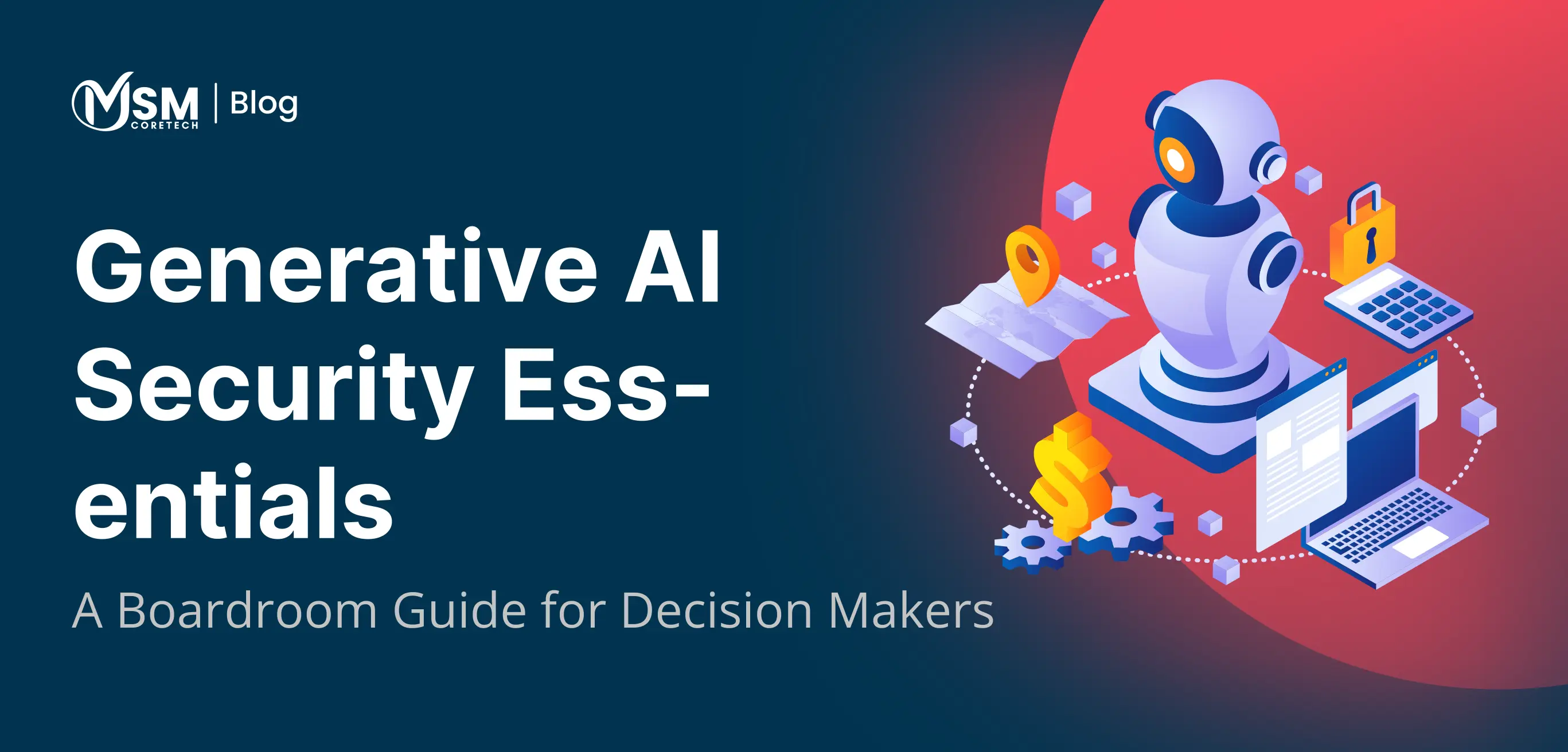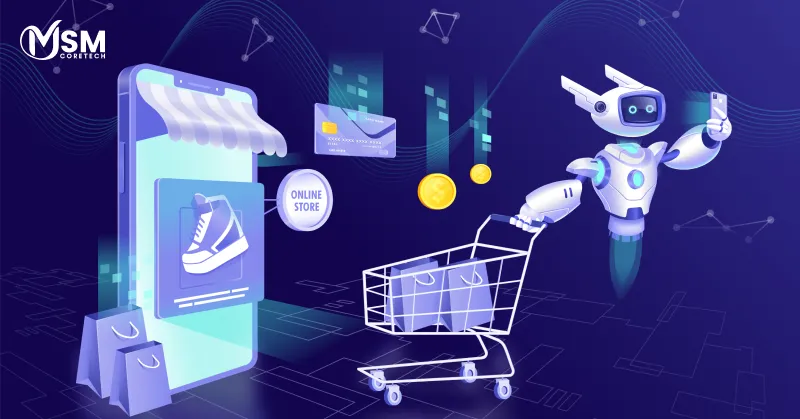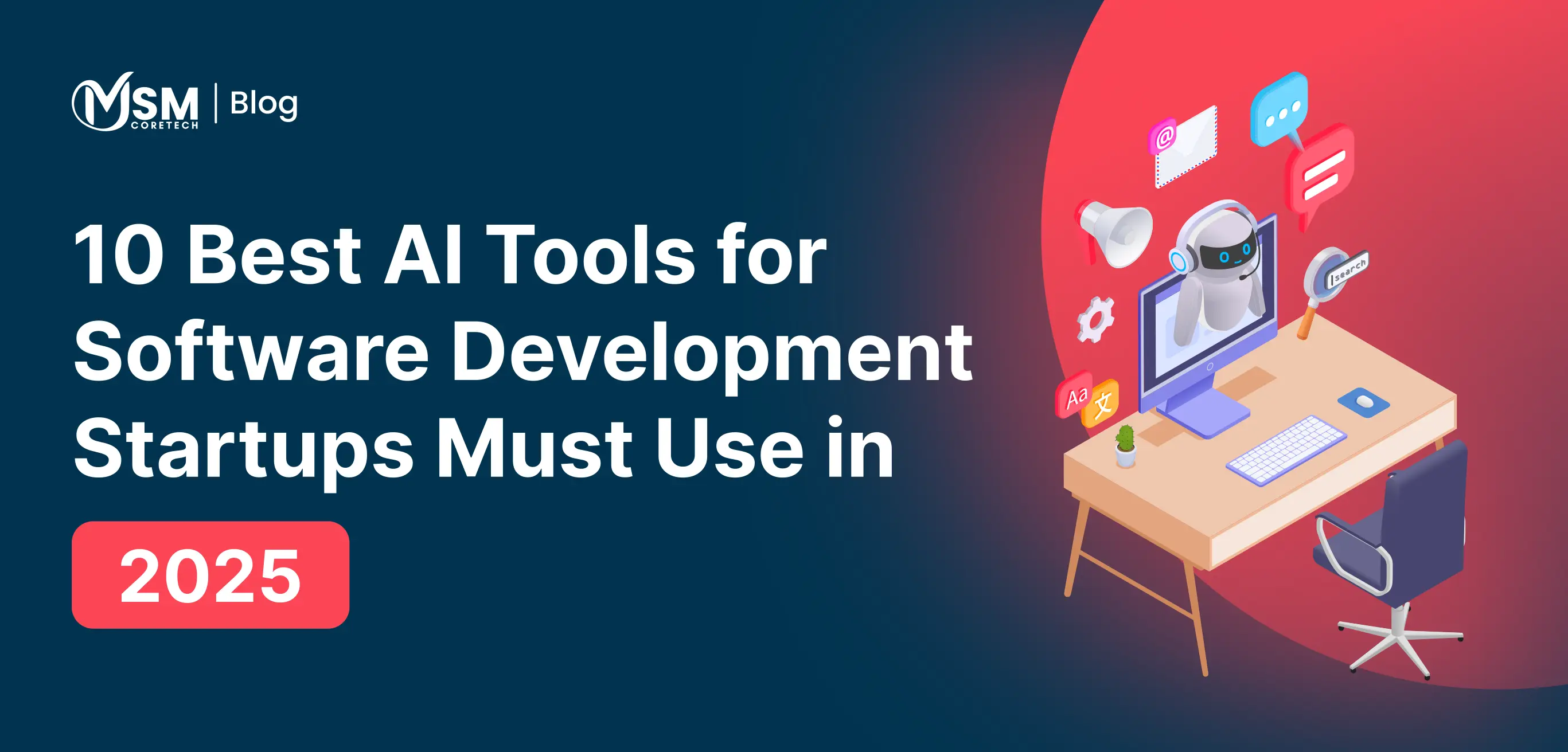Generative AI Security Essentials: A Boardroom Guide for Decision Makers

Generative Artificial Intelligence (AI) is transforming industries at an unforeseen pace. From automating content creation to fostering product innovation, businesses are instantly integrating AI into their core operations. This shift demands that decision makers at the highest levels, such as CEOs, CFOs, CIOs and the whole C-suite, create a firm understanding of the risks and responsibilities integrated with this technology.
Generative AI implementation in business modules features extraordinary opportunities; however, it also introduces new security vulnerabilities that can disrupt operations and damage reputations and can lead to regulatory penalties. Therefore, generative AI security has elevated as an important boardroom concern.
In this post, you will unpack the essentials of generative AI Security tailored for executives, offering insights into risks, governance best practices and strategic oversight to secure your organization’s AI investments.
Understanding Generative AI and Its Business Impact
Generative AI, known as machine learning models, enables crafting original content such as text, images, audio, video or even software code based on patterns learnt from large datasets. Regardless of traditional AI that simplifies or predicts, generative AI produces fresh artifacts that can mimic human creativity.
Today’s businesses employ generative AI in several modules :
- Marketing and communications: AI generated content, social media posts, ads and personalized customer interactions.
- Product design: Quick prototyping and automated creative inputs.
- Software development: AI-assisted code generation and debugging.
- Customer service: AI Chatbots and virtual assistants delivering human-like conversations.
These significant advantages involve instant delivery, cost savings and elevated user experience. But despite this robust security, these benefits can quickly backfire.
Read : Marketing Decisions made by artificial Intelligence
Why Should the C-Suite Prioritize Generative AI Security?
The stakes for executives are high; security failures or misuse of generative AI can result in :
- Intellectual property theft
- Data breaches and regulatory non-compliance
- Brand damage due to offensive or inaccurate AI-generated content
- Fraud and cyberattacks exploiting AI vulnerabilities
- Loss of competitive advantage
Therefore, the C -C-suite generative AI security has been much enhanced from a purely technical issue to a strategic governance topic. And understanding the dynamic threats posed by AI and integrating security into the business strategy is crucial for sustainable growth.
Why Is Board-Level Attention Important for Generative AI Security?
Governance frameworks are finding it difficult to keep up with the rapid adoption of generative AI. What usually begins as employee-enabled experimentation with public tools quickly delves into business-critical integration. Without monitoring, this speed translates into enterprise-wide exposure, from data flowing outside corporate boundaries to unsecured plugins connecting with core systems.
This is absolutely not just a technical matter. But it is a strategic concern, the reason why AI security for C-suite executives is now firmly on the boardroom agenda. The implications are crucial—
- Financial exposure - In certain cases, the damages seem related to money and a lot of it. A breach tied to uncontrolled AI can run into millions in restoration costs, and that’s before the penalties stack on top.
- Risk Reduction - Putting up guardrails in place early can eliminate exposure, whether it's an employee pasting sensitive data into a prompt by mistake or someone trying to misuse the system maliciously.
- Resilience - Stranger systems aren’t just only about defense; they make it simpler to expand AI adoption without crashing into compliance roadblocks later.
- Compliance and regulation - The truth is, regulators won’t wait around if AI exposes sensitive data. Under HIPAA, GDPR or niche industry rules, even a single slip can bring fines and a long trail of paperwork.
- Reputation risk - What that really means is trust. One serious AI related incident can remove years of credibility with customers or partners almost overnight.
- Operational Continuity - And then there’s business influence. If AI processes aren’t safe, they don’t just leak data; they can bring workflows to a slowdown or quite hand over IP to the wrong place.
- Trust assurance - When customers, regulators and even partners can see there’s real oversight in how AI is used, they’re far more comfortable interacting with you.
- Sustainable innovation - Security -first adoption signifies that you get an advantage of faster AI, without the painful rollbacks that come when risks are ignored.
5 Core Generative AI Security Risks and Challenges
To proficiently run generative AI, executives must grasp the prominent risks and challenges integrated with its deployment.
Data Poisoning and Bias
Generative AI models are only as proficient as the data they learn from. If training data is biased, incomplete or intentionally poisoned by malicious actors, the AI can generate harmful or misleading outputs.
- Impact: Misleading content may damage brand credibility and may violate ethical standards or regulations.
- Challenge: Recognising poisoned or biased data needs ongoing data audits and quality controls.
Model Theft and Reverse Engineering
AI models showcase valuable intellectual property. Attackers can seek to extract models by querying APIs repeatedly or exploiting vulnerabilities, essentially cloning the AI without authorization.
- Impact: Competitors or enticing entities could showcase your technology, resulting in financial loss and damage to your brand image.
- Challenge: Safeguarding model extraction needs advanced security techniques such as encryption, access control and usage monitoring.
Adversarial Attacks and Manipulation
Attackers can create particular inputs designed to trick AI systems into producing incorrect, improper or sensitive information.
- Impact: These attacks can be the reason for operational disruptions, expose confidential data, or facilitate misinformation.
- Challenge: AI models must be developed and tested to resist conflicting inputs, an area still evolving quickly.
Data Leakage and Privacy Concerns
Generative AI systems can be constructed on sensitive information, which can unintentionally feature private data through their outputs, a problem known as model inversion.
- Impact: Breaches of privacy laws such as GDPR or HIPAA can result in hefty fines and lawsuits.
- Challenge: Ensuring models do not memorize or expose sensitive training data requires techniques like differential privacy.
Malicious Use and Content Misuse
Generative AI can be exploited to create deepfakes, fake news, or phishing content that harms individuals and organizations.
- Impact: This demolishes public trust and can have legal implications.
- Challenge: Companies must monitor and control how their AI tools are used, preventing abuse.
The Business Consequences of Inadequate Generative AI Security
Overlooking AI security can lead to severe consequences for businesses, involving:
- Financial losses from intellectual property theft or fraud.
- Damage to brand image from offensive or incorrect AI-generated outputs.
- Regulatory penalties for failing to protect user data or comply with AI ethics laws.
- Operational risks such as system downtime caused by adversarial manipulation.
The outcomes from the C-suite translate into material risks that can influence shareholder value, customer loyalty and market position.
Generative AI Governance - 6 Best Practices for the Boardroom
Effective governance is the core of the secure generative AI deployment. Here are the core generative AI governance best practices designed for executives:
Establish Clear AI Policies and Ethical Guidelines
Define organisational principles for running AI use, focusing on transparency, fairness, privacy and accountability. These should meet with your company’s values and regulatory requirements.
Secure Data Management and Quality Controls
- Use only premium quality, vetted datasets.
- Frequently audit data for bias and poison.
- Implement privacy-enhancing technologies such as anonymization and differential privacy.
Implement Robust Model Security Measures
- Encrypt models and data both at rest and in transit.
- Use secure development environments with strict access controls.
- Limit API access through authentication and rate limiting.
Continuous Monitoring and Incident Response
- Implement monitoring tools to detect anomalies or misuse.
- Maintain detailed logs for auditability.
- Create incident response plans for AI-specific threats.
Engage in Regular Risk Assessments and Penetration Testing
To find vulnerabilities, do regular assessments that include simulations of adversarial attacks.
Foster Cross-Functional Collaboration
Include legal, compliance, HR, IT, and business units to create a holistic AI security framework.
How to Integrate Generative AI Security into Your Business Module
AI implementation requires embedding security at every stage of the business module.
Step 1: Align AI Initiatives with Business Strategy
Ensure that AI projects have clear objectives, defined risk appetites and scalable outcomes that support wider corporate objectives.
Step 2: Conduct Comprehensive Risk Assessments
Understand certain security risks relevant to your AI use case, data sensitivity and regulatory environment.
Step 3: Choose Secure AI Vendors and Partners
Vet third-party AI providers for their security posture, transparency, and compliance history.
Step 4: Train Your Workforce
Educate employees and leadership on AI capabilities, risks, and security protocols.
Step 5: Pilot and Iterate
Begin with controlled pilot programs integrating security controls, then expand as you learn and improve.
The Role of the C-Suite in Ensuring Generative AI Security
Board members and executives must lead the charge in AI security:
- Education: Commit to understanding AI technology and threats.
- Policy Setting: Mandate clear governance frameworks.
- Resource Allocation: Fund necessary technology and training.
- Oversight: Require regular reporting on AI security status.
- Ethical Leadership: Ensure AI is used responsibly and fairly.
Your proactive engagement will determine whether generative AI becomes a competitive advantage or a liability.
Emerging Technologies Enhancing Generative AI Security
The security landscape for generative AI is growing fast, with innovations such as:
- Differential Privacy: Adds noise to data to protect individual identities.
- Trusted Execution Environments (TEEs): Secure hardware enclaves for running AI models safely.
- Adversarial Training: Exposes models to hostile inputs during training to build resilience.
- Digital Watermarking: Embeds invisible signatures in AI outputs to trace misuse.
By keeping up with these advancements, organisations can improve their defences against AI.
Preparing Your Organization for Secure Generative AI Adoption
Here are the points that replicate the steps to prepare your organisations for secure Generative AI adoption.
- Conduct Detailed Risk Assessments focusing on your specific business use cases.
- Develop Clear Security and Ethical Policies aligned with organizational goals.
- Implement Strong Technical Controls such as encryption, authentication, and monitoring.
- Invest in Staff Training and Awareness on AI security risks.
- Partner with Trusted AI Vendors who prioritize security and transparency.
- Pilot Projects with Security in Mind before full-scale deployment.
- Regularly review and update your AI governance framework to keep pace with evolving threats and regulations.
Conclusion: Leading with Confidence in the Era of Generative AI
Generative AI shows a bucket of opportunities but with unparalleled challenges. For decision-makers, knowing generative AI security risks and challenges is crucial to unlocking the technology’s full potential safely.
By utilizing generative AI governance best practices, investing in secured development and deployment and encouraging a culture of responsibility, the C-suite can transform AI from a risk into a competitive benefit.
The future belongs to those who innovate with care, ensuring AI serves people ethically, securely and effectively.
Related Blogs

Generative AI in eCommerce: Growth, Benefits & Future Trends
Learn how generative AI is transforming ecommerce by improving customer experience, boosting sales, and shaping future trends.
Read More

AI in Warehouse Management: Costs, Benefits & Real ROI Insights
Discovering how AI is transforming warehouse management across industries and learning about real-world benefits, challenges, pricing models, and ROI strategies
Read More

Top AI Software Development Tools & Uses
Explore the best AI tools for software development in 2025. Learn how AI enhances coding, debugging, testing, automation, and productivity for faster and smarter software engineering.
Read More




